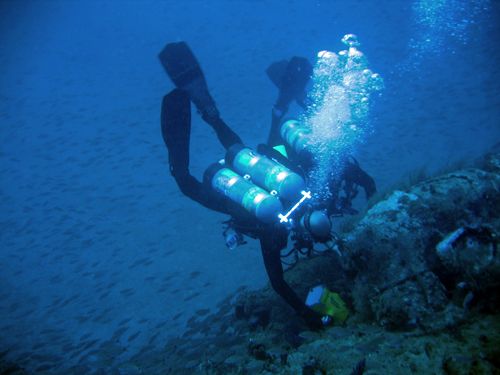Scuba diving is an exhilarating experience, allowing us to explore the underwater world. However, the underwater environment presents unique challenges due to the increased pressure. Understanding the gas laws that govern the behavior of gases under pressure is crucial for safe and enjoyable diving. This article will explore the key gas laws relevant to scuba diving, explaining how they impact a diver’s experience and safety.
The Fundamental Gas Laws Every Diver Should Know
Several gas laws are particularly important for scuba divers. These laws explain how pressure, volume, and temperature affect the gases we breathe underwater, impacting everything from buoyancy to decompression sickness.
Boyle’s Law: Pressure and Volume Relationship
Boyle’s Law describes the inverse relationship between pressure and volume of a gas at a constant temperature. In diving, this means as you descend and pressure increases, the volume of air in your lungs, buoyancy compensator (BCD), and wetsuit decreases.
- Ascending: As you ascend, the pressure decreases, causing the air volume to expand. This requires you to vent air from your BCD and exhale continuously to avoid lung overexpansion.
- Descending: As you descend, the pressure increases, causing the air volume to contract. This requires you to add air to your BCD to maintain neutral buoyancy.
- Impact: Understanding Boyle’s Law is critical for managing buoyancy and preventing barotrauma (pressure-related injuries).
Charles’s Law: Temperature and Volume Relationship
Charles’s Law states that the volume of a gas is directly proportional to its absolute temperature when pressure is held constant. While less directly apparent than Boyle’s Law, it still plays a role in diving.
Imagine filling your scuba tank on a hot day. As the tank cools down, the pressure inside will decrease slightly, reflecting the temperature change. This is less of a practical concern in diving compared to Boyle’s Law, but worth noting.
Dalton’s Law: Partial Pressures of Gases
Dalton’s Law of Partial Pressures states that the total pressure exerted by a mixture of gases is equal to the sum of the partial pressures of each individual gas. This is particularly relevant when considering nitrogen narcosis and oxygen toxicity.
The air we breathe is a mixture of gases, primarily nitrogen and oxygen. As we descend, the partial pressure of each gas increases proportionally to the overall pressure. At depth, the increased partial pressure of nitrogen can lead to nitrogen narcosis, a state of impaired judgment similar to intoxication.
Henry’s Law: Gas Solubility
Henry’s Law describes the relationship between the partial pressure of a gas and its solubility in a liquid. This law is crucial for understanding decompression sickness (DCS), also known as “the bends.”
As you descend, more nitrogen dissolves into your blood and tissues due to the increased partial pressure. During ascent, if you rise too quickly, the nitrogen can come out of solution and form bubbles in your tissues and bloodstream, leading to DCS. Slower ascents and safety stops allow the nitrogen to slowly diffuse out of your body.
FAQ: Gas Laws and Scuba Diving
Here are some frequently asked questions about gas laws and scuba diving:
- Q: What is barotrauma?
A: Barotrauma is an injury caused by pressure differences between air spaces in the body and the surrounding environment. Examples include ear squeezes and lung overexpansion injuries. - Q: What is decompression sickness (DCS)?
A: DCS occurs when nitrogen bubbles form in the body due to a rapid decrease in pressure during ascent. Symptoms can range from joint pain to paralysis. - Q: How can I prevent DCS?
A: Prevent DCS by following safe diving practices, including slow ascents, safety stops, and adhering to dive tables or dive computer recommendations. - Q: What is nitrogen narcosis?
A: Nitrogen narcosis is a temporary altered state of consciousness caused by the increased partial pressure of nitrogen at depth. - Q: How can I avoid nitrogen narcosis?
A: Avoid nitrogen narcosis by limiting your depth and using gas mixtures with lower nitrogen content, such as nitrox;
Practical Applications of Gas Laws in Diving
Understanding these laws translates directly into safer diving practices. By applying these principles, divers can mitigate risks and enjoy the underwater world responsibly.
| Gas Law | Practical Application in Diving |
|---|---|
| Boyle’s Law | Buoyancy control, ear equalization, avoiding lung overexpansion. |
| Charles’s Law | Understanding pressure changes in tanks due to temperature. |
| Dalton’s Law | Understanding the effects of nitrogen narcosis and oxygen toxicity. |
| Henry’s Law | Preventing decompression sickness through slow ascents and safety stops. |
Safe diving practices rely on a solid understanding of gas laws. By comprehending how pressure affects gases underwater, divers can make informed decisions about buoyancy control, ascent rates, and gas mixtures. Remember that continuous education and proper training are essential for minimizing risks. Always consult with experienced dive professionals for personalized guidance. Prioritizing safety ensures that every dive is an unforgettable and positive experience. So, dive smart, dive safe, and enjoy the wonders of the underwater realm.

